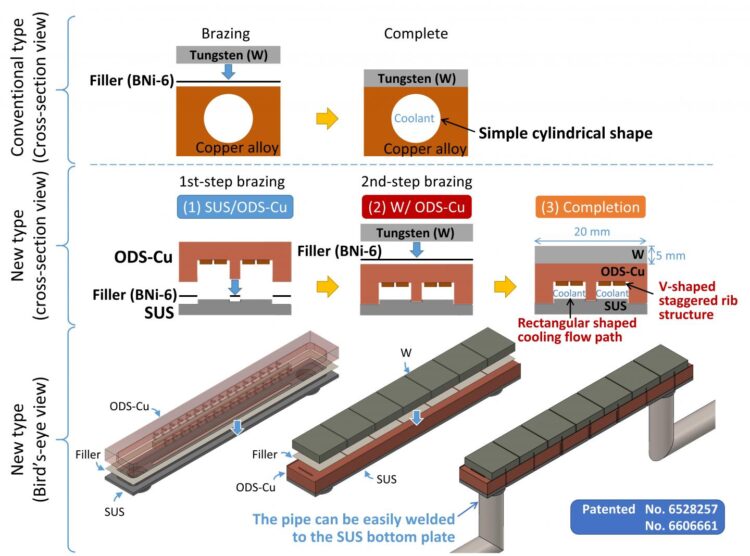This highly contributes to producing the efficient heat removal component for fusion reactor
The oxide dispersion strengthened copper alloy (ODS-Cu) is superior in thermal conductivity, electrical conductivity, heat resistance and friction tolerance, etc. Although the ODS-Cu can be expected to have various industrial applications, its joint with other materials is extremely difficult because of its intrinsic poor weldability. The research group of Dr. Masayuki Tokitani in the National Institutes of Natural Sciences (NINS) National Institute for Fusion Science (NIFS) has developed an extremely novel joint technique that enables us to fabricate any component made of ODS-Cu. This technique highly contributes to producing the efficient heat removal component for the fusion reactor.
Copper alloys, e.g. ODS-Cu and tungsten (W) are supposed to be used in the component for which the highest heat removal performance is required in a fusion reactor. This component is called “divertor”. High heat influx outcoming from high temperature plasma in a fusion reactor is received by the W armor of the divertor. The accepted thermal energy is then transferred to the cooling water through the ODS-Cu heat sink. For the conventional cooling structure, a cylindrical cooling flow path channel is machined in the heat sink. Recently, a new cooling structure is expected to improve the heat removal performance. The new structure has a rectangular shaped cooling flow path channel and V-shaped staggered ribs on the top wall of the flow path (Fig. 1). In order to make the new structure, we must seal the pre-processed cooling channel with the lid made of ODS-Cu or stainless steel (SUS). Since this sealing must prevent any leakage of cooling water or air, the leak-tight joint technique between ODS-Cu and ODS-Cu (ODS-Cu/ODS-Cu) and SUS and ODS-Cu (SUS/ODS-Cu) must be developed. Furthermore, after the new structure of the heat sink is obtained, we have to joint the W armor tiles on to it. This means that multi-step jointing should be required to fabricate the single heat removal component.
In order to fabricate the new type of the heat removal component, the research group has developed an extremely novel joint technique named “Advanced Multi-Step Brazing (AMSB).” Generally, the “brazing” is a popular joint technique of two materials, as in the following procedures. First, a filler material is inserted into the joint interface of the two materials. Second, the entire structure is heated up to the melting temperature of the filler material. After the cooling down phase of the heat treatment, the two materials are jointed by the adhesive force of post-solidified filler material. By advancing the conventional brazing, the research group had already developed the technique to tightly joint ODS-Cu and W in 2016. In this technique named “advanced brazing technique (ABT),” the BNi-6 (Ni-11%P) is used as filler material, and a compressive load with ~0.54 MPa is applied in the direction perpendicular to the joint interface by using carbon springs and flanges. Then, the post set-up of entire structure is heated up to be 960 degrees Celsius to melting the filler material (Fig. 2). This time, the research group has conducted the brazing test many times to find the optimized brazing conditions such as heating temperature, time and compressive load for leak-tight joint. Consequently, they found the optimized conditions to realize all of the following special features.
(1) The joint can be applied for the combination of ODS-Cu/ODS-Cu and SUS/ODS-Cu.
(2) The joint is completely leak tight.
(3) The joint has areal contact, not line- or spot-like contact.
(4) The joint strength is as high as the original strength of ODS-Cu.
(5) The joint does not degrade even after a repetitive (brazing) heat treatment.
By applying the special features, the AMSB enables us to produce the new structure of the ODS-Cu heat sink.
The new type of the divertor heat removal component was successfully produced by using the AMSB. This component showed an excellent heat removal capability under the reactor-relevant conditions with ~30 MW/m2 (Fig. 3). This heat removal capability is the world’s highest heat removal performance to date.
Associate Professor Tokitani in the research team states, “The AMSB can be useful for jointing ODC-Cu with other materials besides SUS and W. We would like to apply this technique developed in fusion research to industrial applications in the future.”
###
References
[1] M. Tokitani et al., Nucl. Fusion 61 (2021) 046016.
[2] M. Tokitani et al., Nucl. Fusion 57 (2017) 076009.
[3] M. Tokitani et al., J. Nucl. Mater. 538 (2020) 152264.
Media Contact
Masayuki Tokitani
[email protected]
Related Journal Article
http://dx.





